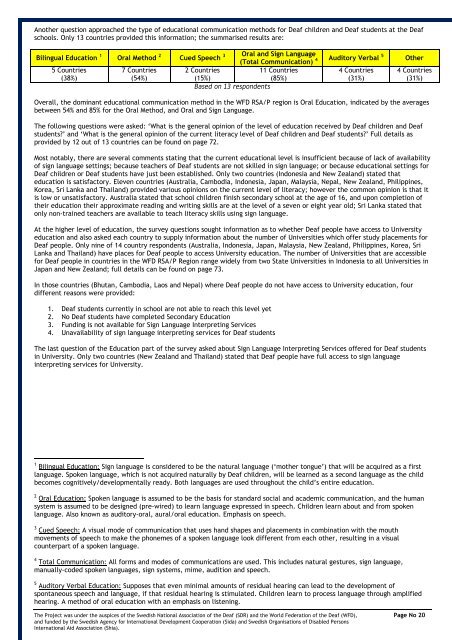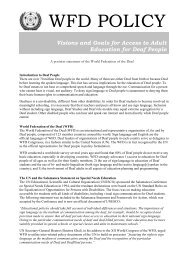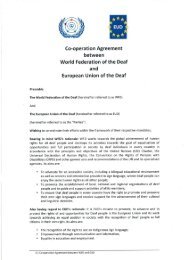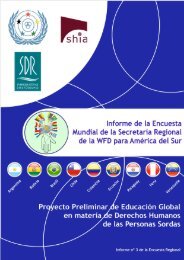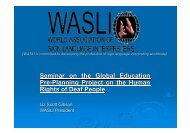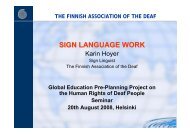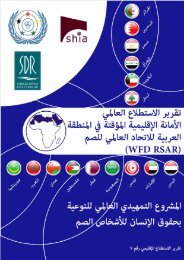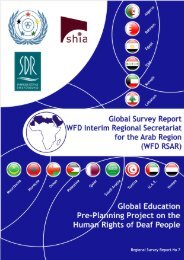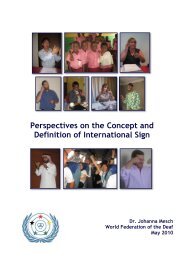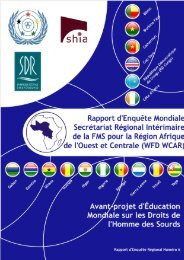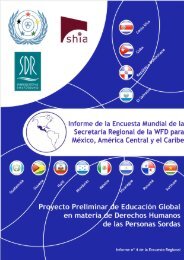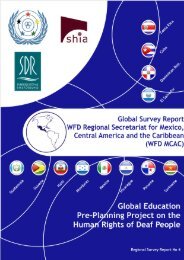RSA/P Regional Survey Report No 2 (English Version) PDF - World ...
RSA/P Regional Survey Report No 2 (English Version) PDF - World ...
RSA/P Regional Survey Report No 2 (English Version) PDF - World ...
You also want an ePaper? Increase the reach of your titles
YUMPU automatically turns print PDFs into web optimized ePapers that Google loves.
Another question approached the type of educational communication methods for Deaf children and Deaf students at the Deaf<br />
schools. Only 13 countries provided this information; the summarised results are:<br />
Bilingual Education 1 Oral Method 2 Cued Speech 3 Oral and Sign Language<br />
(Total Communication) 4 Auditory Verbal 5 Other<br />
5 Countries<br />
(38%)<br />
7 Countries<br />
(54%)<br />
2 Countries<br />
(15%)<br />
11 Countries<br />
(85%)<br />
4 Countries<br />
(31%)<br />
4 Countries<br />
(31%)<br />
Based on 13 respondents<br />
Overall, the dominant educational communication method in the WFD <strong>RSA</strong>/P region is Oral Education, indicated by the averages<br />
between 54% and 85% for the Oral Method, and Oral and Sign Language.<br />
The following questions were asked: ‘What is the general opinion of the level of education received by Deaf children and Deaf<br />
students?’ and ‘What is the general opinion of the current literacy level of Deaf children and Deaf students?’ Full details as<br />
provided by 12 out of 13 countries can be found on page 72.<br />
Most notably, there are several comments stating that the current educational level is insufficient because of lack of availability<br />
of sign language settings; because teachers of Deaf students are not skilled in sign language; or because educational settings for<br />
Deaf children or Deaf students have just been established. Only two countries (Indonesia and New Zealand) stated that<br />
education is satisfactory. Eleven countries (Australia, Cambodia, Indonesia, Japan, Malaysia, Nepal, New Zealand, Philippines,<br />
Korea, Sri Lanka and Thailand) provided various opinions on the current level of literacy; however the common opinion is that it<br />
is low or unsatisfactory. Australia stated that school children finish secondary school at the age of 16, and upon completion of<br />
their education their approximate reading and writing skills are at the level of a seven or eight year old; Sri Lanka stated that<br />
only non-trained teachers are available to teach literacy skills using sign language.<br />
At the higher level of education, the survey questions sought information as to whether Deaf people have access to University<br />
education and also asked each country to supply information about the number of Universities which offer study placements for<br />
Deaf people. Only nine of 14 country respondents (Australia, Indonesia, Japan, Malaysia, New Zealand, Philippines, Korea, Sri<br />
Lanka and Thailand) have places for Deaf people to access University education. The number of Universities that are accessible<br />
for Deaf people in countries in the WFD <strong>RSA</strong>/P Region range widely from two State Universities in Indonesia to all Universities in<br />
Japan and New Zealand; full details can be found on page 73.<br />
In those countries (Bhutan, Cambodia, Laos and Nepal) where Deaf people do not have access to University education, four<br />
different reasons were provided:<br />
1. Deaf students currently in school are not able to reach this level yet<br />
2. <strong>No</strong> Deaf students have completed Secondary Education<br />
3. Funding is not available for Sign Language Interpreting Services<br />
4. Unavailability of sign language interpreting services for Deaf students<br />
The last question of the Education part of the survey asked about Sign Language Interpreting Services offered for Deaf students<br />
in University. Only two countries (New Zealand and Thailand) stated that Deaf people have full access to sign language<br />
interpreting services for University.<br />
1 Bilingual Education: Sign language is considered to be the natural language (‘mother tongue’) that will be acquired as a first<br />
language. Spoken language, which is not acquired naturally by Deaf children, will be learned as a second language as the child<br />
becomes cognitively/developmentally ready. Both languages are used throughout the child’s entire education.<br />
2 Oral Education: Spoken language is assumed to be the basis for standard social and academic communication, and the human<br />
system is assumed to be designed (pre-wired) to learn language expressed in speech. Children learn about and from spoken<br />
language. Also known as auditory-oral, aural/oral education. Emphasis on speech.<br />
3 Cued Speech: A visual mode of communication that uses hand shapes and placements in combination with the mouth<br />
movements of speech to make the phonemes of a spoken language look different from each other, resulting in a visual<br />
counterpart of a spoken language.<br />
4 Total Communication: All forms and modes of communications are used. This includes natural gestures, sign language,<br />
manually-coded spoken languages, sign systems, mime, audition and speech.<br />
5 Auditory Verbal Education: Supposes that even minimal amounts of residual hearing can lead to the development of<br />
spontaneous speech and language, if that residual hearing is stimulated. Children learn to process language through amplified<br />
hearing. A method of oral education with an emphasis on listening.<br />
The Project was under the auspices of the Swedish National Association of the Deaf (SDR) and the <strong>World</strong> Federation of the Deaf (WFD), Page <strong>No</strong> 20<br />
and funded by the Swedish Agency for International Development Cooperation (Sida) and Swedish Organisations of Disabled Persons<br />
International Aid Association (Shia).


